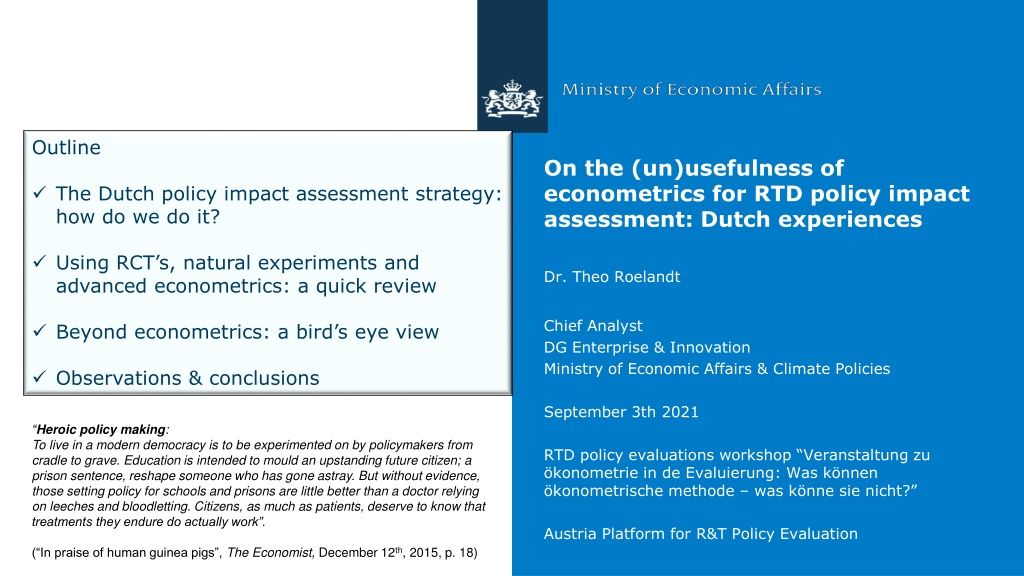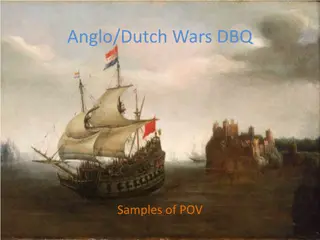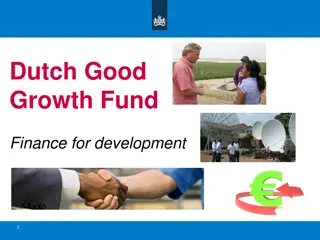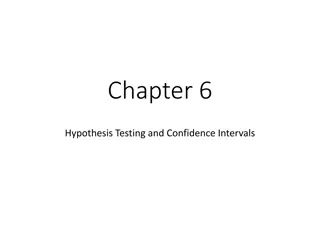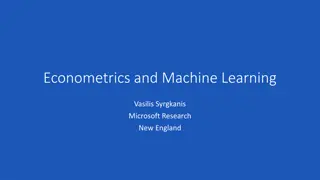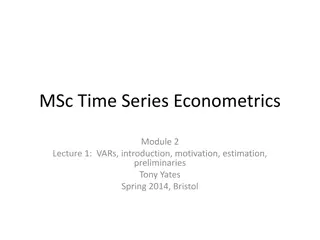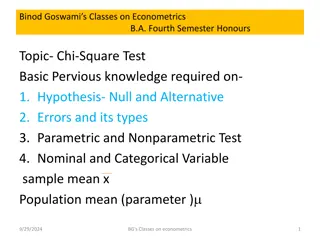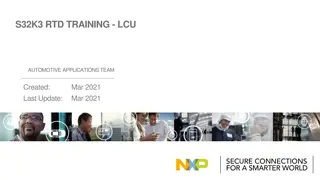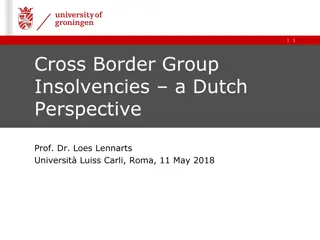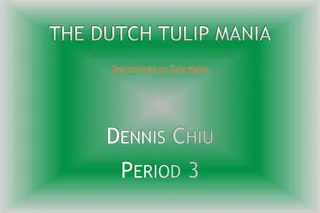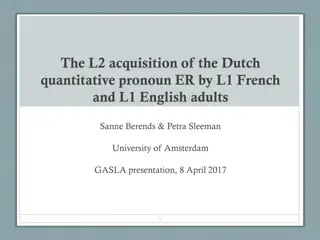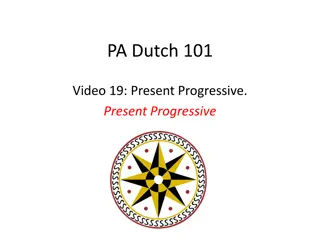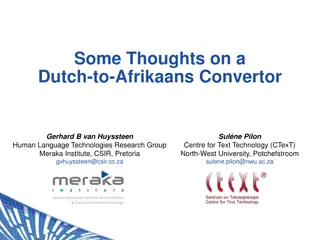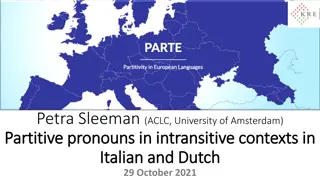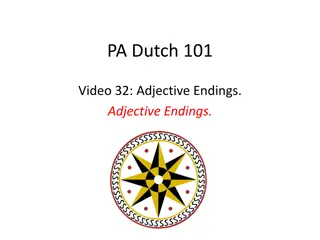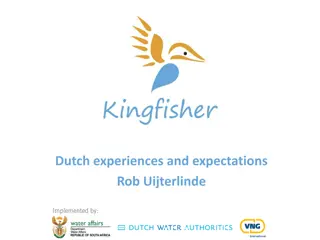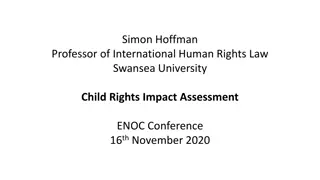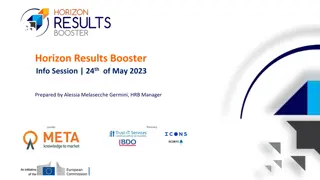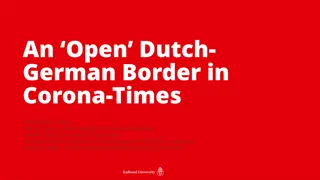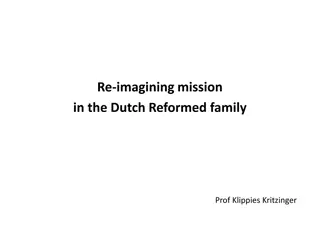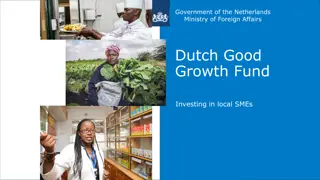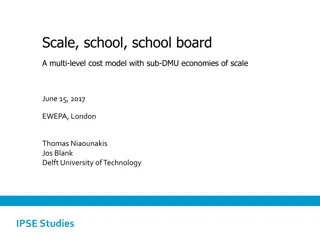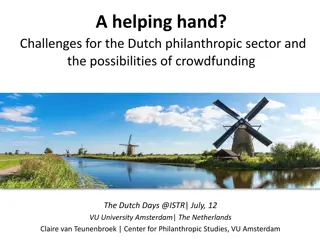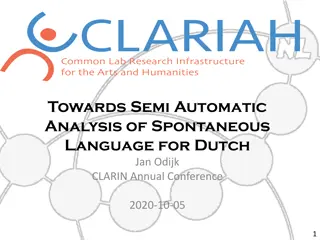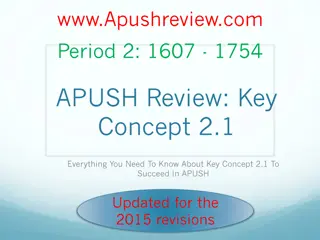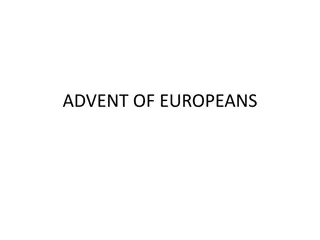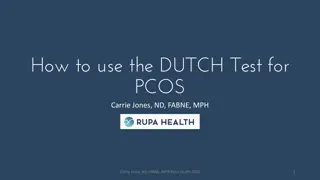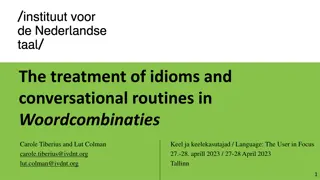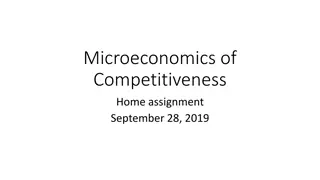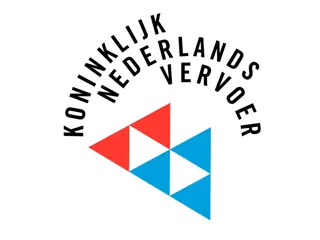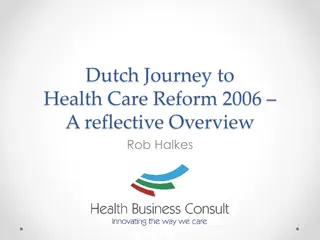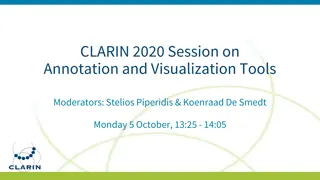Dutch Experiences with Econometrics in RTD Policy Impact Assessment
Dutch policy impact assessment relies on a mix of RCTs, natural experiments, and advanced econometrics to evaluate the effectiveness of interventions. Dr. Theo Roelandt, Chief Analyst at the Ministry of Economic Affairs & Climate Policies, emphasizes the importance of evidence-based policymaking in modern democracies. The assessment strategy involves developing a consistent Policy Intervention Theory, monitoring key performance indicators, and investing in high-quality micro-data sets. Various econometric methods, such as regression discontinuity and difference-in-difference, are used to assess policy impacts, with a focus on combining quantitative and qualitative methodologies.
Download Presentation

Please find below an Image/Link to download the presentation.
The content on the website is provided AS IS for your information and personal use only. It may not be sold, licensed, or shared on other websites without obtaining consent from the author. Download presentation by click this link. If you encounter any issues during the download, it is possible that the publisher has removed the file from their server.
E N D
Presentation Transcript
Outline On the (un)usefulness of econometrics for RTD policy impact assessment: Dutch experiences The Dutch policy impact assessment strategy: how do we do it? Using RCT s, natural experiments and advanced econometrics: a quick review Dr. Theo Roelandt Chief Analyst DG Enterprise & Innovation Ministry of Economic Affairs & Climate Policies Beyond econometrics: a bird s eye view Observations & conclusions September 3th 2021 Heroic policy making: To live in a modern democracy is to be experimented on by policymakers from cradle to grave. Education is intended to mould an upstanding future citizen; a prison sentence, reshape someone who has gone astray. But without evidence, those setting policy for schools and prisons are little better than a doctor relying on leeches and bloodletting. Citizens, as much as patients, deserve to know that treatments they endure do actually work . RTD policy evaluations workshop Veranstaltung zu konometrie in de Evaluierung: Was k nnen konometrische methode was k nne sie nicht? Austria Platform for R&T Policy Evaluation ( In praise of human guinea pigs , The Economist, December 12th, 2015, p. 18)
Our Policy Impact Assessment Strategy Developing a consistent Policy Intervention Theory. Monitoring key performance indicators (macro, policy areas, sectors, institutions & interventions). Evaluating policy instruments using state of the art (econometric) methodologies and data : ex post, ex ante and small scale policy experimentation, counterfactual & control groups, natural experiments using econometrics. Investing in creating high quality (linked) micro-data sets and methodologies that can reveal causality. 2 In Praise of Heroic Policy Making: how? (2)
Around the policy circle: data & analytics Policy statistics & indicators policy preparation Data-analyses Expost evaluatie & natural experiments Exante evaluation & Social experiments CBS RvO policy evaluation policy design BAT Key Performance Indicators, Zero point measurement & Data-development data-assessments policy implementation Monitoring & policy progress assessment 3
How do we do it? 2ndbest: natural experiments using econometrics on (linked) micro-data (ex post evaluation): regression discontinuity , difference-in-difference , propensity score matching 3thbest: advanced econometrics (no control group) 4thbest: descriptive statistics and perceptions In all cases: combining quantitative and qualitative methodologies and data Evaluation Quality = methodology * data2 4 Evaluation Quality = methodology * data2
Some RTD-examples of what it delivers RCT: short & long term impact innovation vouchers scheme Natural experiments: - Innovation Credit - Innovation Box (profit based tax credit) - Applied Research Organisations - Eurostars - Technology Foundations - SBIR - WBSO (labour based tax credits) 5 In Praise of Heroic Policy Making:
Randomised Controlled Trials Scheme / estimation period Aim Methodology Results Innovation vouchers, 2004-2005 More utilisation by SMEs of research performed by public knowledge institutes - Estimation method: analysis of survey results on the basis of a linear probability model - Control group: non-selected applicants in a lottery procedure in 2004 (first round of allocation of innovation vouchers) Positive effect on projects assigned to public knowledge institute. [Out of every ten vouchers, eight were used for a project that would not have been assigned to a knowledge institute, one was used for a project that would have been assigned anyhow, and one voucher was not used.] Innovation vouchers, 2002-2017 More utilisation by SMEs of research performed by public knowledge institutes - Estimation method: panel analysis (fixed effects included in robustness analysis) - Control group: non-selected applicants in lottery procedures during the years 2004-2005 - Positive effects in the short, medium and long tem on employment and the survival probability and in the long term also a positive effect on business R&D. - No effect found on labour productivity. SME Innovation Stimulation Scheme Topsectors (MIT), consisting of various subschemes; 2012-2015 More research and innovation in SMEs, particularly in the context of the top sector approach - Estimation method: fixed effects panel analysis, reflecting a difference-in-difference approach - Control group: non-selected applicants in lottery procedures during the years 2013-2015 - Positive effects on business R&D. - Effects on business performance not estimated. 6 In Praise of Heroic Policy Making:
Differences in long term performance between firms with or without innovation voucher (in %) 16% 14% 12% 10% 8% 6% 4% 2% 0% Higher survival Rate More use of R&D tax credit More R&D-activities (in hours) More employment Higher labor productivity 7
Natural experiments (I) Scheme and estimation period Aim Methodology Results Experimental design: whether or not a grant/credit has been obtained Innovation credit, 2006-2016 More high-risk development projects, aimed at new products and processes - Estimation method: fixed effects panel analysis, reflecting a difference-in- difference approach. - Control groups: 1) rejected applicants and 2) as non-applicants a selection of WBSO users with on average similar characteristics as the treatment group of approved applicants Positive effects on business R&D and business performance (particularly employment and survival probability; mixed results for effects on turnover) Dutch participation in Eurostars, 2008- 2019 More R&D and innovation, particularly in SMEs - Estimation methods: difference-in difference and regression discontinity design (in the latter case: project review score as control variable) - Control groups: 1) rejected applicants and 2) selection of WBSO users based on propensity score matching - Positive effect on business R&D - No effect found on business performance (turnover, employment and labour productivity) Innovation box, 2008-2013 More business R&D and innovation and a better investment climate for R&D related business activity - Estimation method:difference-in- difference and, as related approach, first difference. - Control group: WBSO users that did not use the Innovation box - Positive effect on business R&D (BFTB: 0.54). - No significant effect on innovation perfomance, measured as turnover share of new and improved products. - Effects on further business performance (e.g. turnover, employment) not estimated 8 In Praise of Heroic Policy Making:
Natural experiments (II) Scheme and estimation period Aim Methodology Results Experimental design: whether or not a grant/credit has been obtained Applied research organisations TO2: co- operation in R&D and innovation with firms, 2008-2018 More innovation - Estimation method: fixed effects panel analysis, reflecting difference-in difference - Control groups: 1) WBSO users in general and 2) WBSO users based on propensity score matching - Estimation methods: difference-in difference and regression discontinity design (in the latter case: project review score as control variable) - Control groups: 1) WBSO-users that did not apply for SBIR and 2) rejected applicants Positive effects on business performance (value added and employment) and also on business R&D Small Business Innovation Research (SBIR), 2007-2015 More innovation, particularly in SMEs - Mixed results for effects on business performance (turnover and employment) - Virtually no effect on business R&D Technology Foundation STW, 1996- 2011 More technical research in public institutes, to be utilised by firms - Estimation methods: difference-in- difference, regression discontinuity design and fixed effects / random effects panel analysis (project review scores as control variable in case of regression discontinuity design) - Control group: rejected applicants - Positive effects on publication performance of researchers, measured by the number of publications and the number of public-private co- publications - Mixed results for effect on patent appllications 9 In Praise of Heroic Policy Making:
Natural experiments (III) Results Scheme and estimation period Aim Methodolgy Experimental design: impacts of policy developments vary among groups of firms, dependent on firm characteristics WBSO (R&D tax scheme), crisis measures, 2007-2010 Mitigating the effect of the economic crisis on business R&D - Difference-in-difference - Control treatment groups: different groups of WBSO users Positive effects on business R&D Positive effects on business R&D WBSO (R&D tax scheme), introduction of starters facility and extension of the first bracket of R&D expenditure, in which the tax credit rate is relatively high, 1994-2003 Traditional regressions: advanced econometrics More business R&D - Difference-in-difference and, as related approach, first difference - Control and treatment groups: different groups of WBSO users Scheme and estimation period Aim Method Results WBSO (R&D tax scheme), 2011-2017 More business R&D Estimation method: fixed effects panel analysis, including instrumental variables in order to control for dependence of the WBSO tax credit rate on the amount of R&D expenditure ( synthetic user cost of R&D approach) Positive effects on business R&D; BFTB on R&D wage expenditure: 0,90 (effect on total R&D expenditure not estimated because of data limitations) Furthermore: positive effects of business R&D on innovation performance (turnover share of new and improved products) and business performance (labour productivity) Sample: WBSO users; no control group 10 In Praise of Heroic Policy Making:
The (un)usefulness of econometrics in policy evaluation Very usefull indeed: more inside in what works and what doesn tin single agent policy instruments (one actor, one measurable target, financial of character). Provides hard evidence on policy impact: additionality, effectiveness & bang for the buck . Depoliticise the policy debate with facts. More bang for the buck from tax payers money. It encouraged to make more work of data-development and policy monitoring, right from the start of new policy initiatives. But not in all cases: Most modern policies are more than single agent instruments (transformative, systematic, multi-actors, complex policy mixes and interactions): econometrics doesn t help much E.g. mission oriented innovation policy, industry carbon reduction policies, digitalisation policies. Call for new methods and data and theory of change-methodologies . 11 In Praise of Heroic Policy Making:
Evaluation: complexity, policy interventions & the use of econometrics high Complexity (actors, factors & dynamics) Usefulness of econometrics low Type of policy interventions Tax incentives <> Business R&D-grants <> Collaborative R&D <> Ecosystem/Cluster <> Policy Mix <> System & Transiton Policies 12
A new evaluation framework for systemic & transformative policies? Internationally, evaluation techniques still in its infancy. No Gold Standard available. Therefore, Dialogic i.c.w. Harvard Kennedy School for Public Policy developed a new framework See Janssen (2016): What bangs for your bucks?, CID-paper no 69. Transformative policies like TSA are about adapting socio-economic systems to open opportunities for a set of new technologies The framework assesses how much policy contributed to changes or transitions in these technological innovations systems (TIS) 13 Dutch Ministry of Economic Affairs 28 April 2017
Systemic Evaluation Framework: birds eye view Highlights Transformative policy is selective, process-oriented and multi-instrumental. We develop a framework for assessing transformative policy design and impact. We apply the framework to evaluate the Dutch Topsector approach. The Topsector approach adheres to many of the design principles for transformative policy. Impact mostly consists of engaging private parties in fortifying existing knowledge networks. 14 In Praise of Heroic Policy Making:
It delivers another kind of insight on policy impact TSA seems to be effective (i.e. more public private partnership) and efficient (i.e. social benefits > social costs) TSA improved the innovation system Observations/dilemma s Structural changes take time to occur Differences between top sectors depending on state of technology and quality of the innovation system Bottom up versus top down => role of government in setting goals? Improvements in policy design of TSA => next phase more focus on societal challenges and goals 15 Dutch Ministry of Economic Affairs 28 April 2017
Wrapping up & discussion Evalu????? ??????? = ??? ??????? ????2 Econometrics helps policy makers to know the causal impact for single agent instruments and it helps increasing the quality and impact of public expenditures. Transformative & systemic policies and complex policy mixes demand for new methodologies. Internationally still in its infancy. In the Netherlands: a new evaluation experts committee installed developing new methodologies, next to the econometric tool box available. Will bring its advice in the Summer 2021. Don t trow out the baby with the bathwater! : use econometrics where it can and is usefull, but develop and adopt at the same time new methodologies for transformative and systemic policy mixes. Combine quantitative & qualitative methodologies. 16 In Praise of Heroic Policy Making:
